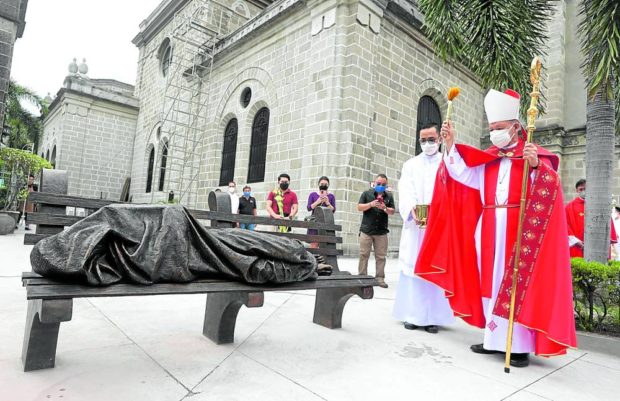
VISUAL SERMON | The life-size artwork, which suggests that Jesus Christ is one with the most marginalized in society, is meant to be a “visual sermon 24 hours a day,” according to Canadian sculptor Timothy Schmalz. (Photo by NIÑO JESUS ORBETA / Philippine Daily Inquirer)
MANILA, Philippines — The “unusual” visual depiction of Jesus Christ as a vagrant sleeping on a bench — identifiable only by the crucifixion marks on his feet since his face and body are covered by a blanket — has found a home in front of the Manila Cathedral in Intramuros.
Manila Archbishop Cardinal Jose Advincula, along with Canadian Ambassador to the Philippines Peter James MacArthur, unveiled the life-size sculpture called “Homeless Jesus” before the 10 a.m. Mass at the cathedral on Palm Sunday.
In his homily, Advincula said that the image “speaks and screams for us to hear the voice of Jesus and see him in our brothers and sisters who have no place in our society and our hearts.”
In a statement, the Manila Cathedral expressed hope that the sculpture would not become “a place for visits or pictures, but [also] a space to deepen our prayer, and to convert and change our hearts.”
“As we look at Jesus who is homeless, may we also see the poor who, according to Pope Francis, ‘pay the price of corruption,’ and so lead us to choose competent and honest leaders this coming national elections,” it said.
For Fr. Reginald Malicdem, the rector of Manila Cathedral, the sad truth was that even until now, Jesus was still homeless.
“If we have a place in our house for a new appliance or latest gadget but we have no place for a new baby, or it gets killed even though it’s still in the womb, Jesus is still homeless,” he said during the Lenten recollection livestreamed on Saturday, a night before the unveiling of the sculpture.
“If there is money to spend for trolls that spread lies and disinformation but we have no money for education, the budget to build schools in remote areas is still lacking and teachers are not given their proper salary, Jesus remains homeless,” he added.
Enough space
For Canadian sculptor Timothy Schmalz, his artwork is a “visual sermon 24 hours a day.” The bronze metal sculpture, designed to have enough space for someone to sit on the bench, suggests that Christ is with the most marginalized in society, he said.
“Oftentimes we see Jesus, more or less, Christ the King, with beautiful robes or a beautiful body,” Schmalz said at the Lenten recollection.
According to the artist, he drew inspiration for his work from the Bible verse Matthew 25:35-36, “For I was hungry and you gave me something to eat, I was thirsty and you gave me something to drink, I was a stranger and you invited me in. I needed clothes and you clothed me, I was sick and you looked after me, I was in prison and you came to visit me.”
COME AND SEE | If you go to the Manila Cathedral in Intramuros, Manila, you’re not going to miss the bronze metal sculpture of Jesus sleeping on a park bench and wrapped in a blanket. The “Homeless Jesus’’ was unveiled by Cardinal Jose Advincula, Manila archbishop, before the 10 a.m. Palm Sunday Mass. (Photo by NIÑO JESUS ORBETA / Philippine Daily Inquirer)
“What is fascinating about this passage is that He makes a direct connection toward himself and the marginalized,” Schmalz said.
He said that he designed Homeless Jesus to have enough space for someone to sit on the bench, adding that “if I could add a little bit of space so someone could really sit there, that might make the sculpture more powerful.”
Schmalz recalled that as he was making the sculpture, the face of Jesus was more visible but he thought of covering it up to let people interpret it on their own.
“Two things happen: One, you can put in your own imagination of someone that you know of or two, you can put in the face of Jesus that’s in your heart,” he said.
Unlike in other religions where God was always known to be the King looking down, in Catholicism there was a graphic representation of Jesus through the biblical text that says “No, I am those people—I am the hungry, the thirsty, the stranger,” he said.
Constant reminder
According to Schmalz, his sculpture is a “constant reminder that it’s our spiritual duty to help the poor and see God within those poor.”
Replicas of his work, inspired by the artist spotting a homeless person wrapped in a blanket in Toronto, Canada, have been installed in churches, cathedrals, and other places around the world, including Buenos Aires, Capernaum, New York, Madrid, Melbourne, Rome, Singapore, and the Vatican.
The first one was installed at Regis College in the University of Toronto in Canada in 2013.
The other one found at the Vatican was first rejected by cathedrals in Toronto and then New York City until it found an admirer in Pope Francis, according to a 2013 report by Canada-based CTV News.
In 2020, Schmalz’s artwork went viral after someone called the 911 emergency hotline upon mistaking the statue outside St. Barnabas Episcopal Church in Ohio, United States, for a real-life homeless man.
RELATED STORIES
Bishop David asks Filipino voters: Will you vote for Jesus or for Barabbas?
11 years of interactive display on Jesus’ death, resurrection in Taguig
Tagle tells faithful to deepen understanding of Jesus this Holy Week

